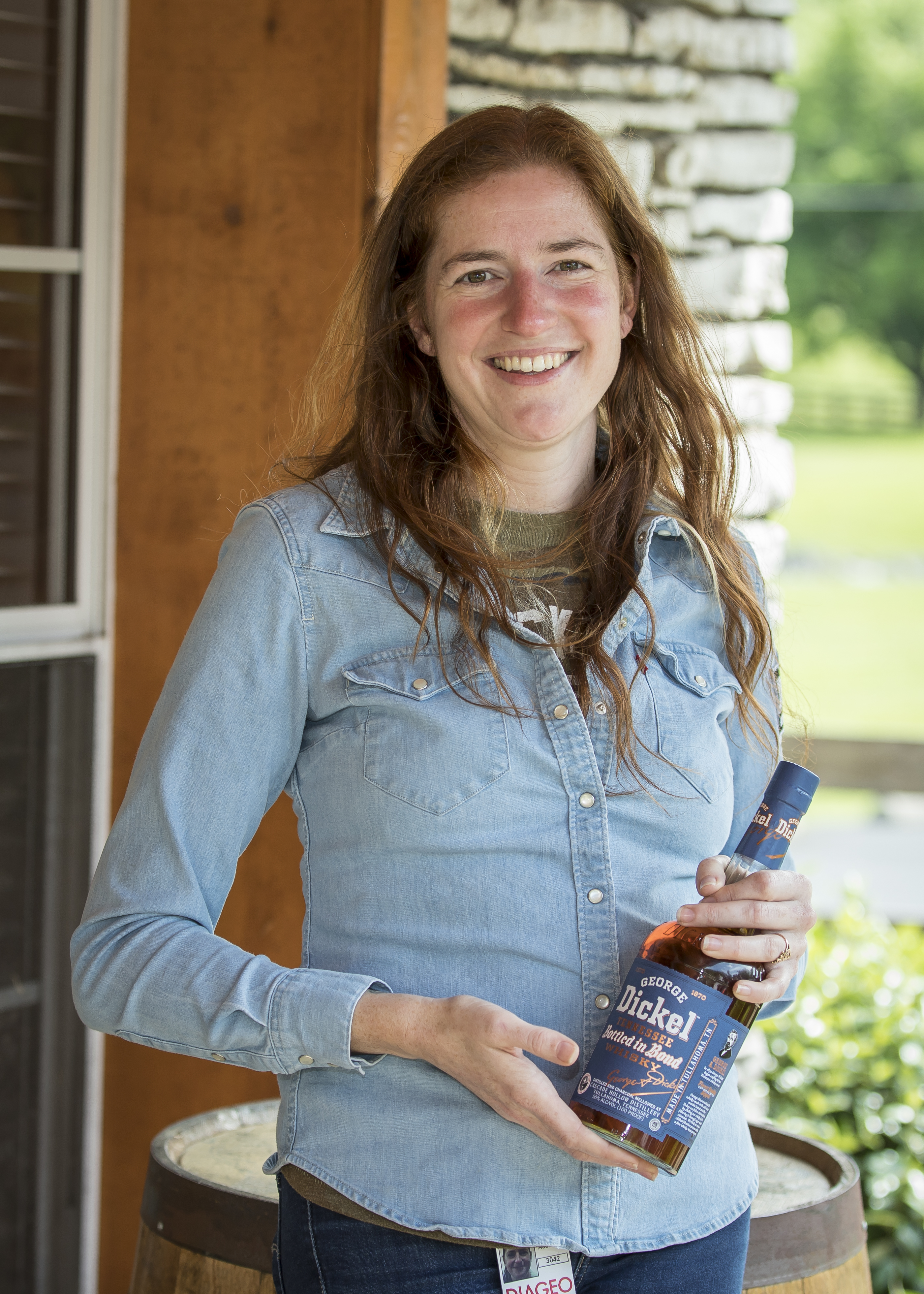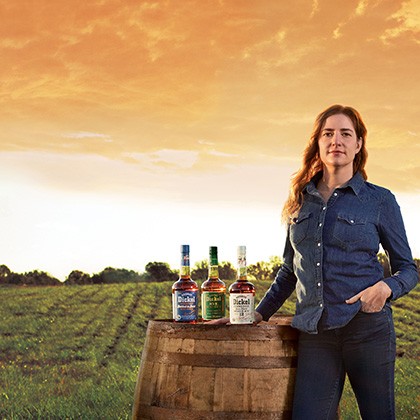In 2018, Nicole Austin landed a hell of a gig at Cascade Hollow Distilling (formerly George Dickel Distillery) — taking on the dual role of General Manager and Head Distiller. This dream job didn’t come through happenstance. Austin has a degree in Chemical Engineering from Manhattan College, which led to her becoming the Master Blender for Kings County Distillery in New York in 2010 — where she helped define the award-winning whiskey’s style. Her whiskey knowledge runs deep and her time at Cascade Hollow has already helped reshape the future of one of the most iconic Tennessee whiskey brands.
Austin’s got her work cut out for her, though, as George Dickel’s path has been pretty bumpy over the years. The former late-1800s grocery store blend saw great highs pre-Prohibition. But over the past century, it’s been shuttered, born again, shuttered a second time, and changed hands. In Austin, the company has found a leader who is cognizant of its history while remaining tapped into the 21st-century whiskey scene. She’s also willing to take risks — a spirit that was underscored by the release of George Dickel Bourbon just this year, though the shingle has long been associated with “Tennessee whiskey.”
When you speak to Austin about the juice coming off her stills and resting in rickhouses in Tullahoma, Tennessee, you can feel that you’re speaking to someone who is craft-oriented. Recently, I chatted with her about how she navigates warehouses full of whiskey she didn’t make but has to blend, the state of whiskey’s regionality, and what excites her on the horizons.
https://twitter.com/Diageo_NA/status/1246136150105915402?s=20
What’s the difference between Cascade Hollow Distilling and George Dickel?
It’s a good question. The distillery is in a valley, called Cascade Hollow, which is the site of the original distillery. George Dickel, the Tennessee Whiskey brand, has been around since 1870. And George himself actually ran the general store in the city of Nashville. He was a German immigrant and he and his wife, Augusta, ran the store together. And as was quite common at that time, the folk would buy whiskey and spirits from local distilleries, small farm distilleries, or larger operations all over. And they would blend it or flavor it at the store and sell it under their own brand. This was very typical in the mid to late 1800s.
So George Dickel Tennessee Whiskey is the brand, right?
Right.
The distillery, Cascade Hollow, produces whiskey mainly for George Dickel, but of course, you can have other brands that come out of there. That’s particularly common in the U.S. — to have several different whiskey brands that originate from the same distillery. They could be made the same way and blended differently, or possibly the distillery could run different mashes at different times to make different things.
So when you’re looking at your operations, you know George Dickel’s going to take up X amount of time, but then also we have to get enough barrels for other products or brands. How do you look at your day-to-day when you’re balancing all of that?
It’s one of the most challenging things. For a year, you’re making a plan of how to make Tennessee whiskey, what we need, how much time could we spend making other things? And you kind of have to predict — because whiskey takes a long time — so you have to predict five, ten, 20 years in the future what you think you’re going to need and produce against that.
It’s actually quite a complex process. Obviously, you lose whiskey every year. It’s just evaporation that’s called the angel share. So you have to plan, how much do I need to distill today to sell the amount I think I’ll need to sell of that product in four years? And that’s different than the amount you need to distill today to sell something in eight years since the angel’s share is going to be different.
When you look at the older barrels in your warehouses, you’re dealing with juice that was laid down before you were the distiller. Do you ever go back into those and sort of find, “I get what you were going for here, but this isn’t quite what we’re going for now”? Or are you surprised by all the gems? How do you process dealing with some else’s whiskey that you have to build your whiskey on?
It’s a bit of both. Plans change, right? And when you look into the crystal ball and try and predict the future, we’re hardly ever right. So you always have to deal with that.
It’s always the question of, “how do you take what you have and try and do the best job you can do to make it fit the whiskey that you want to make today?” And some of that is exactly as you describe it, discovering some gems, that you’re like, “man, those barrels have been sitting there for a while. Just because they didn’t fit Dickel 12, they’re still lovely!” So, maybe I can come up with a brand that could utilize them better.
And then sometimes it’s instances of balance, right? What’s important right now, and how do I use the whiskey to its best potential?

So how does that apply to George Dickel in the bottle?
I would say at George Dickel, we have some extra challenges because this distillery has such a checkered history. It’s been shut down, then turned back on at various times. It’s passed through different ownership. And it’s always been a little bit of an underdog, sort of under-appreciated brand.
That all makes the challenge particularly difficult in this case — because it’s not an even, steady supply, which makes it even harder to sort those things out. This is why I’ve done a lot of one-offs, limited-time offerings. Those are the whiskeys that I can be confident in the quality of but wasn’t necessarily making any promises about repeatability. That’s one of the reasons I could release the Dickel Bourbon, because I had to get to that place of being confident that not only could I make this one blend once, but that I had the whiskey to be able to repeat that again next year.
What was the process behind you putting together a bourbon, as opposed to a Tennessee whiskey release?
When I took the role here, my job didn’t exist before. Various people have held different titles, like Head Distiller over the years. But this particular role of being a General Manager and Distiller has responsibilities on the brand, marketing, and sales sides, as well as production. Because of that, I had this unique position and this unique opportunity to make sure that nothing changes — make sure that Dickel 12 stays the same every year and that Dickel classic tastes the same every year, which is actually quite hard to do. When I came in, I had to look holistically at everything and think about what’s the best way to use this whiskey?
So I did a massive review of literally every aging lot that we had in our warehouse that was over four years old. It was thousands of samples, which was fun. But on the back of that, I was able to get a better understanding of what we had and what these whiskeys might be capable of.
I didn’t come in necessarily with any ideas of what I wanted to achieve. What I wanted to understand was what do we have in our warehouses, and then start to make notes and kind of think about where that could lead.
I started to notice we had a lot of whiskeys that, to me, reminded me a lot more of a typical balanced lovely bourbon. I think that had I not come around, their destination would have been to be blended in against those bigger, bolder barrels and sort of lost forever. I thought, what a shame. They’re really lovely on their own. They deserved their own bottle to shine.
So because I had the opportunity, also as the general manager, I was able to make that happen. I said to the team, “I think we should go create this new brand of Dickel Bourbon.” I chose to use that word because I felt like it was the most honest description of what’s in the bottle, it tells someone who’d buy it exactly what they can expect it to taste like, which is a lovely balanced bourbon, vanilla forward, toffee, some fruit and cherry notes. It’s what you would expect from a nice bourbon.

I’m a huge fan of Tennessee whiskey. I grew up in the era where Tennessee whiskey is what you had on your home bar, and Kentucky bourbon is what you kept in the garage under the sink for when you were on your own.
The good old days.
There was a clear differential in the quality and there still is that today, no matter how much marketing from Kentucky is used. Do you feel like you’re fighting against the barrage of how mammoth Kentucky bourbon has become? Or are you just like, “Fuck it, I’m doing my own thing and the whiskey is going to speak for itself?” Or is it even something you worry about?
I definitely do worry about and pay attention to that. I will fully admit that when I was first becoming really passionate about whiskey, Tennessee whiskey was not a category that I really paid much attention to. I really wasn’t paying much attention to it until where we were trying to create our own regional designation in New York in the form of Empire Rye. And that really forces you to sit down and really think about what the value of a regional identity really is.
It’s really quite hard to do. So that’s when I looked at Tennessee whiskey because they had historically been so successful at it. But in some ways, I think they were almost too successful at separating themselves from bourbon. Because, of course, Tennessee whiskey is bourbon, right?
Right.
The foundation of the Tennessee whiskey’s rules literally copies and pastes the bourbon statute. So Tennessee whiskey is a regional identity of bourbon that utilizes the Lincoln County Process and is made in the state of Tennessee. And I think that thread was lost a little bit.
I’ve been talking about that for a few years, but I think a lot of real bourbon enthusiasts are maybe missing out on some of these really excellent, beautiful bourbons because they’re sold under the “Tennessee whiskey” moniker, and they think that that’s somehow something different. So I think that connection has value, and I definitely believe there’s room for everything to exist in the world. I think it’s exciting that the shelf is getting more diverse.
We’re getting all these regional designations, it’s fun. It’s more good whiskey in the world. Why would you not want that?
You come from the craft world and you can see what’s happening in Washington, Texas, back in New York, Indiana, etcetera. What have you seen recently that’s excited you about the direction of whiskey or distilling?
You know what excited me recently, I was a judge for the American Craft Spirits Association for their competition and there was a whole category of hopped whiskeys. There are a lot of historic roots of using hops in whiskey. But I totally admit, I always kind of rolled my eyes at it. It was like, these don’t taste good and they’re never going to taste good. And I was judging them and there was one that was amazing, Wigle Hopped Whiskey. It tasted so good.
That’s what I love about what’s happening in American craft spirits right now: It’s surprising. For everything you think you know right now about whiskey, there’s probably someone out there right now plotting how to defy you. I take great delight in that. I love to be proved wrong.
https://www.instagram.com/p/CQy6t_2sqaG/







